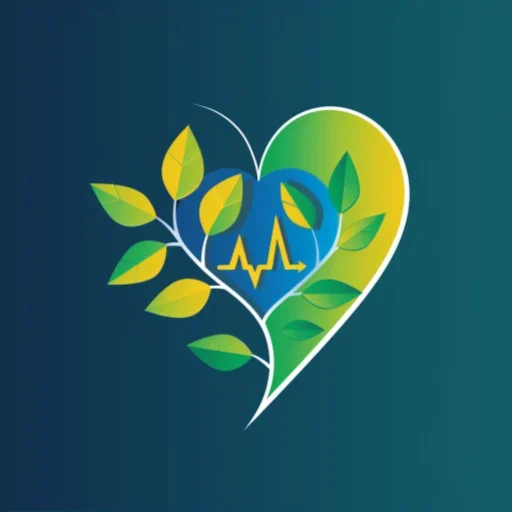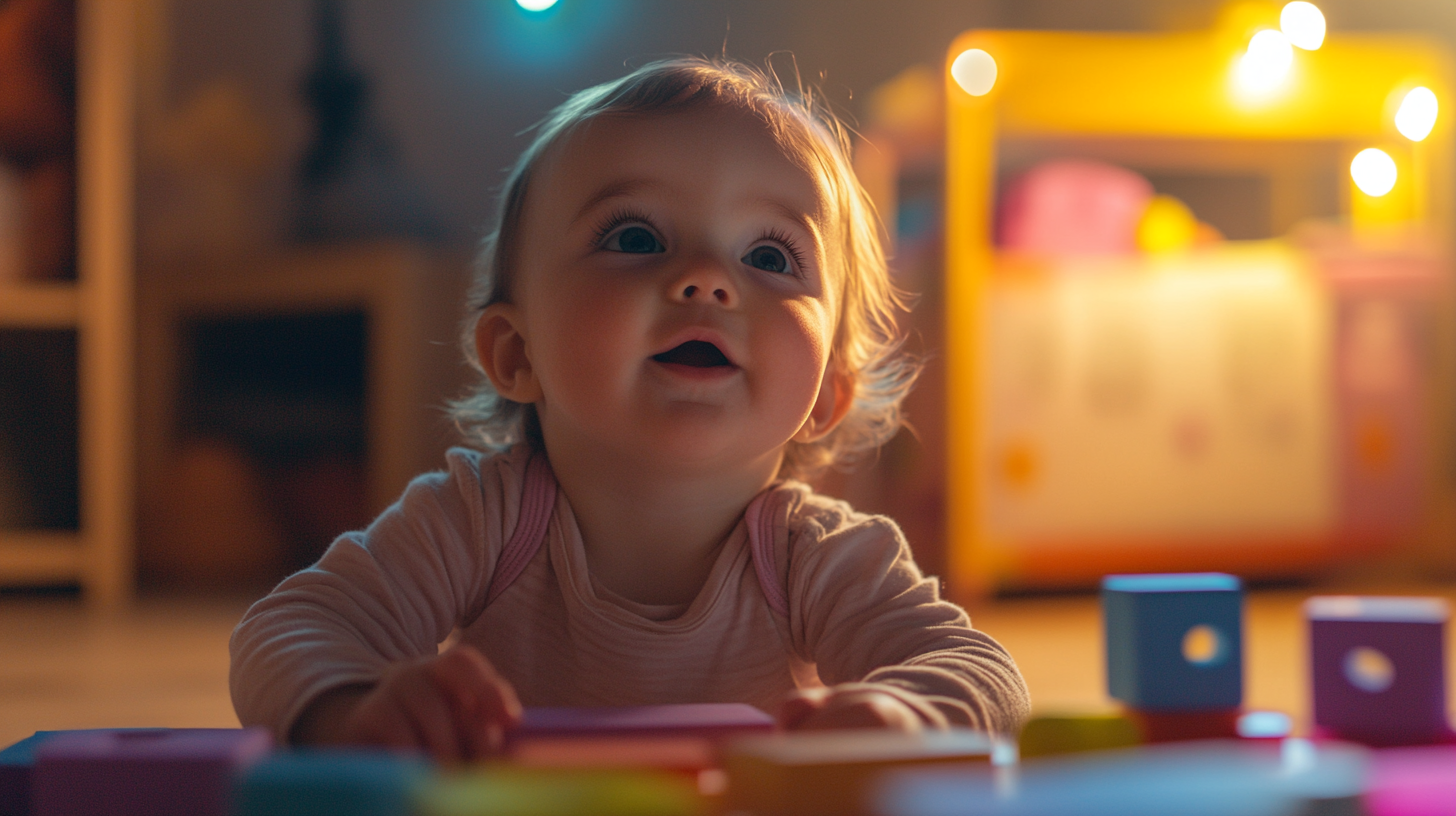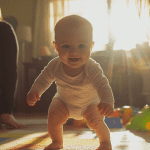1-Year-Old Language Development
At just one year, you’re likely to hear the sweet sounds of “mama” and “Dada,” although their vocabulary is still quite limited. Here’s what to look for:
- Say a handful of words: Words like “hi” and “bye” may start to pop up, but don’t be alarmed if they only stick to a few.
- Imitate sounds: Your little explorer will be curious, mimicking your voice and babbling as they discover sounds.
- Respond to cues: Turn their head at sounds and respond to your voice? That’s a great sign!
- Use gestures: Expect some pointing and eager expressions as they communicate their needs.
2-Year-Old Language Development
As your toddler approaches the age of two, prepare for an explosion in vocabulary! They might:
- Expand their vocabulary: By 24 months, they could be using around 50 words. Exciting, right?
- Link words together: Two-word combinations like “want juice” begin to emerge, showcasing their growing understanding.
- Identify body parts: Watch them proudly point to their nose or eyes during your games!
3-Year-Old Language Development
At three years old, your little chatterbox is ready to engage with the world through words:
- Speak clearly: You should be able to understand about 75% of what they say.
- String words together: Expect sentences made of three to six words detailing their adventures!
- Follow directions: Simple commands become a fun challenge. They might even be eager to please by following your lead.
4-Year-Old Language Development
Welcome to the world of a “big kid!” At this age, your child might:
- Speak in complex sentences: Their storytelling abilities will shine, and even new listeners can understand.
- Identify colours and shapes: Learning goes beyond vocabulary; now they can point out colours and shapes around them!
- Understand time concepts: They’ll start grasping daily routines and can express their wants in clearer ways.
Understanding these milestones is a powerful way to sow the seeds of conversation and connection. Every child develops at their own pace, and that’s perfectly okay! If you have concerns about your child’s speech and language development, don’t hesitate to reach out to a paediatrician or a speech pathologist. Let’s celebrate each babble, word, and sentence together!
“Every child develops on their own timeline, but the best way to help develop your baby’s language skills is to simply talk to them,” says Rahil Briggs, Psy.D., a child psychologist at The Children’s Hospital at Montessori in New York City. “The number-one way children learn to speak and boost their vocabulary is by listening to their parents at home.”
We turned to speech and language experts to learn more about child verbal development, along with what to expect at every age. Ahead, find all the answers to your child’s speech milestones, from 1 to 4 years old.
When Do Babies Start Talking?
1-Year-Old Language Development
Your little one is just beginning to communicate beyond crying. At this age, your child should be able to do the following:
- Say a handful of words: Your toddler still has a limited vocabulary, but you can help it grow by reading out loud and talking to them every day. At this age, the main concern is that words like “mama” and “Dada” refer specifically to their parents.
- Imitate your voice: Even though your child isn’t saying many words, they’re babbling a lot and attempting to imitate the sounds of others.
- Respond accordingly: Your baby’s ability to recognise voices and sounds is crucial at this age. They should be responding to your actions, as well as attempting to communicate through gestures.
- Follow simple directions: Your child should be able to respond to basic commands like “up” or “no.”
- Use hand and body gestures: Gesturing is a natural form of communication and helps children build their cognitive and language skills.
2-Year-Old Language Development
This age is critical for gauging if a child is on track with speech. Around this period, your growing toddler should be able to:
- Expand their vocabulary: By 24 months, your child should be using about 50 words regularly.
- Link together words: You should also notice your toddler beginning to put together two-word sentences.
- Use pronouns: Understanding personal pronouns like “me” and “you” starts here, though your child may mix them up.
- Identify objects and body parts: Your child should be able to point to their body parts and name them.
3-Year-Old Language Development
Your little one is now developing into quite the chatterbox. At this age, they should be able to:
- Speak clearly in simple sentences: After age 3, you should be able to understand at least 75% of what your child is saying.
- String multiple words together: Children start forming sentences with three to six words.
- Choose the right words: Your child should be able to name things and ask for what they want verbally.
- Follow two-part requests: Children this age can understand and act on simple multi-step commands.
4-Year-Old Language Development
You’re now in the “big kid” territory. By age 4, your child should be able to:
- Speak clearly in more complex sentences: Even strangers should be able to understand what they say.
- Identify colours, shapes, and letters: Your child should name at least some common colours, shapes, and letters.
- Understand the concept of time: Your child should recognise the order of activities throughout the day.
- Follow more complex commands: They should be able to follow three- or four-step instructions.
The Bottom Line
It’s important to remember that all children are different, and every child develops at a unique rate. Milestones should be viewed as estimates rather than strict guidelines. If you have questions or concerns about your child’s language development, don’t hesitate to reach out to a paediatrician or healthcare provider for further assistance.

| Key Points | Details |
|---|---|
| Overview of Language Development | Language skills significantly progress from infancy to preschool years, with distinct milestones at 1, 2, 3, and 4 years old. |
| 1-Year-Old Language Development | Children begin to say a few words, imitate sounds, respond to their names, and follow simple commands. |
| 2-Year-Old Language Development | Vocabulary expands to about 50 words, children start linking words into simple sentences and can identify body parts. |
| 3-Year-Old Language Development | Children speak in simple sentences, understand multiple-step commands, and their speech becomes clearer to others. |
| 4-Year-Old Language Development | Preschoolers can tell stories, identify colours and letters, follow complex commands, and express their needs clearly. |
| Communication Strategies | Parents can boost language development by talking, reading, and engaging with children in conversation. |
| When to Seek Help | If a child struggles with understanding or producing language, consultation with a paediatrician is recommended. |
| Individual Development | Each child develops at their own pace; milestones serve as guidelines rather than strict criteria. |
“`



